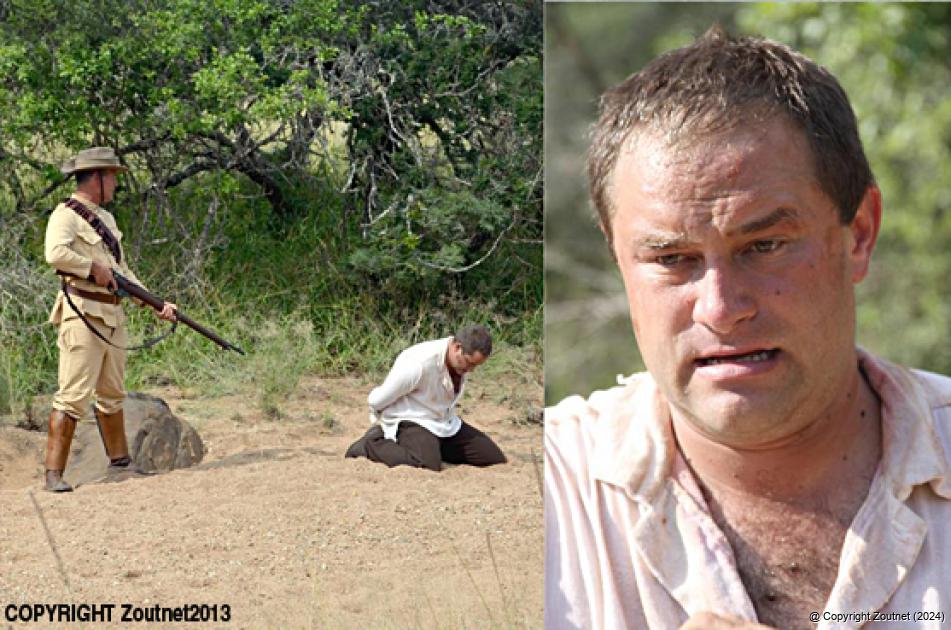
One re-enactment of the Morant documentary that was very close to the real deal (too close for comfort!), was when the firing squad of four men, armed with four .303 rifles charged with blanks, fired into the back of Ronnie Visser (right), playing the role of his great grandfather’s brother, Floris Visser. This scene was filmed on the farm of Dennis Ball. On the left side, Ronnie can be seen kneeling in the sand, waiting for the rest of the squad to come and fire.
The filming of the ‘Breaker’ Morant documentary in the Soutpansberg area by Breaker Productions Australia, in co-operation with a South African team, although exciting, did not match the expectation that “at last the South African version of the actions (atrocities?) of the Bushveldt Carbineers (BVC) during the Anglo-Boer War would be shown”.
Morant and Peter Handcock were executed by a British firing squad on 27 February 1902 for murdering prisoners of war and civilians. “Breaker” is described as a legendary figure and folk hero by some in Australia.
The production team, with Nic Bleszinski as co-author and co-director, stayed in the Soutpansberg area from 10 to 21 April, after which they left for the concentration camp cemetery in Polokwane and filming in Pretoria and Johannesburg.
“We got involved after being reassured by the South African component of the production team that this was most certainly going to be a balanced portrayal of the real deal. It would screen the viewpoints of Australian military lawyer James Unkles, as well as the contents of the novel of Nick Bleszinski (Shoot straight you bastards!) and this would all be balanced by our own South African historic input. We soon realised that it was a tall and somewhat wishful objective…” said Charles Leach, author of The legend of Breaker Morant is dead and buried. Leach has been described by Prof Louis Changuion, emeritus professor in history, as probably the leading expert in the world on research about the facts surrounding the BVC involvement in the Zoutpansberg from May 1901 to April 1902.
Some errors during the filming of the re-enactments were corrected after Prof Changuion and Leach objected, e.g. that the eight boers were wearing bandoliers after being held prisoner for two days. The fact that a youngster of 14 years was shot with the eight Boers was not shown. The shooting of black witnesses by the BVC in this incident was not re-enacted. It remains to be seen whether the shooting of Van Staden and his two sons, after they had to dig their own grave, will be screened. “When we prepared the grave, one of the Australians remarked that 'this is going to make us look really bad',” said Hardus and Ariëte Haasbroek, on whose farm this scene was filmed.
One re-enactment that was very close to the real deal was when the firing squad of four men, armed with four .303 rifles charged with blanks, fired into the back of Ronnie Visser (31), playing the role of his great-grandfather’s brother, Floris Visser. This scene was filmed on the farm of Dennis Ball.
“Some pieces of unburned powder actually lodged under his skin, which immediately turned a rather bright pink. Obviously many faces, such as the director's, producer's and even the armourer's, turned equally bright red,” Leach remembers. There was only one First Aid Kit on site and it was put to good use. Fortunately, Leach, being a local tour guide, had a kit in his vehicle. Ronnie remarked that he had no idea that he was expected to portray this event so realistically! “To re-enact what happened stirs up something in your heart, being a direct descendant. But the filming experience was wonderful,” Ronnie said, bearing the ordeal without complaint.
Floris Visser was shot after a night attack by the BVC on a house where Boer soldiers lodged. The real attack occurred on the farm Duivelskloof, but was filmed at the house that formerly belonged to the late Betty Noakes. The Stone Henge property now belongs to Mr Eddie da Silva and is a listed heritage site.
Leach concedes that Bleszinski’s dream of having the contents of his book recorded as a dramatized documentary has come true. “That is very commendable. I complimented him on that during my interview and remarked that he had achieved much more than I had,” Leach said.
The time for South Africa to produce an own documentary or film portraying the South African version of the events has probably finally come.











